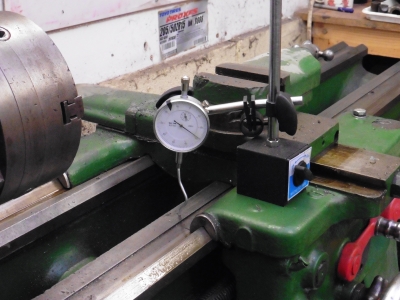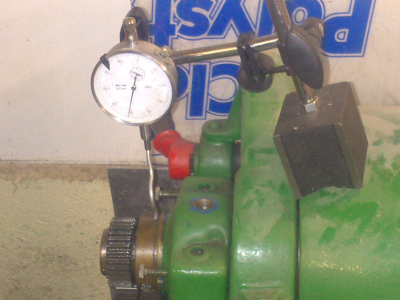The Rebuild Begins
September 2014
With the Rush (sort of) finished, or at least with it only being worked on a small amount of the time, it was about time I turned my attentions to the lathe. I bought a kit of new felts and a rebuild book from the States, some punches, and with that was ready to go. (The book is published by Steve Brooks of Ilion Industrial Services, unfortunately they don't have a website, but sell on Ebay and Amazon)

Before doing much, I thought I'd better take some measurements to see how bad things were, which in turn will give me an idea of what work I need to do
Measuring the Ways
A simple test of the ways is to mount a dial gauge on the carriage and put the end of the gauge on the flat part of the ways. This is only born on by the tailstock, which normally will have much less use than the carriage. So you assume that this part will have no wear. Then by moving the carriage along and measuring the change in height, you can get an idea of how much wear there is on the V ways.

The table below shows the difference in height between the carriage and flat of the ways in mm and thou. I've zeroed it at the tailstock end.
| Distance from Headstock /mm | Wear /mm | Wear /inch |
|---|---|---|
| 0 | 0.34 | 0.013 |
| 20 | 0.27 | 0.011 |
| 30 | 0.29 | 0.011 |
| 40 | 0.30 | 0.012 |
| 50 | 0.32 | 0.013 |
| 70 | 0.33 | 0.013 |
| 90 | 0.33 | 0.013 |
| 100 | 0.34 | 0.013 |
| 150 | 0.34 | 0.013 |
| 200 | 0.34 | 0.013 |
| 250 | 0.32 | 0.013 |
| 300 | 0.28 | 0.011 |
| 400 | 0.18 | 0.007 |
| 500 | 0.10 | 0.004 |
| 600 | 0.03 | 0.001 |
| 700 | 0 | 0 |
So in brief, the answer is, lots of wear. :-( It's mostly towards the headstock as you'd expect. In fact, although wear is quite bad in relation to the tailstock end, it's actually pretty flat around the headstock, for 6 inches at least. However beyond there it gets rapidly worse. So I've two options here - either put up with it, as for most of the work I've been doing, it won't make much difference; or get the bed professionally reground. I'd prefer to regrind it if not ridiculously expensive, though I need to look into it in detail as it may also mean shimming the gearbox and things downwards to match.
Headstock
The next thing to check are the main spindle bearings in the headstock. This is done with the "broom handle" test as described in Southbend manuals of the time. A dial gauge is put on the spindle, and a broom handle inserted into it, leaving about 2 foot protruding. You then lever down on the end of the handle, and zero the dial; then push up on it with "75Kg of force". This is to squash the oil out of the bearing so that you get the genuine clearance, which you measure on the dial gauge. The clearance should be 0.0007 - 0.001" according to the rebuild guide, though I've seen figures up to 0.0015 quoted elsewhere.

The front came out at 0.0024", so out of spec but not badly so. The rear was a bit of a shocker though; it moved visibly and with an audible "clunk". The reading was 0.017", nearly half a mm. So something would obviously have to be done there. Hopefully there would be enough slack in the adjustment to take it up. Only one way to find out...